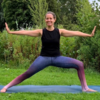Ho'oponopono is a method of forgiveness and healing from Hawaii, which I have practiced on a recurrent basis last few years. Each time again, it provides me new insights and helps with my personal development. Ho'oponopono also helped me in my yoga practice on the mat, by practicing from within. In this blog I will tell more about it, so it hopefully also could help you.
Ho’oponopono and dr. Ihaleakala Hew Len[1]
The problem- and conflict resolution method Ho'oponopono became known by the story about dr. Ihaleakala Hew Len. In 1983 dr. Ihaleakala Hew Len started to work at the psychiatric department of the state prison Kaneohe in Hawaii. In four years he was able to heal 28 out of 30 prisoners without talking to or direct contact with those prisoners. He healed them by reading the prisoners’ files on a daily basis and thereby he wondered what in him was so dark, negative, violence and/or mean that there was such a thing in his world. And each time he could find a reason in his heart, he said a few simple phrases out loud.
It is noteworthy that Dr. Ihaleakala Hew Len didn’t talk about healing someone else, but about cleaning himself, erasing information in his subconscious mind and about taking responsibility for the problems he faced in his life.
Practicing Ho'oponopono
Applying Ho'oponopono is very simple. You do this by saying the following phrases (preferably out loud):
- I love you
- I am sorry
- Please forgive me
- Thank you
Acceptance and awareness during your yoga practice by using Ho'oponopono
Ho'oponopono is a method that is intended to solve problems. It helps me to look at issues from a different perspective, to become aware of my own participation in a problem, to accept it and to let it go to make space for healing. The effects I experienced due to Ho'oponopono vary from changing my perspective whereby I don’t perceive something as an issue anymore to changes in the ‘external’ situation.
I practice Ho'oponopono both on as off the yoga mat. For example off the mat when I am facing a conflict. But it definitely also helped me during my asana practice on the mat. For example when the time in a yoga posture seems beyond reasonable; the moments where I am focusing at when I can come out of the posture instead off what I can do in the posture. Or when the warm yoga room (in a hot Bikram yoga class) just feels to hot. And the more I fight such feelings or take them for the only truth possible, the worse it gets. And of course I also sometimes would like to blame the teacher in these situations….. at first. Until I am starting to remember again that I am exactly where I am supposed to be, to learn exactly what I am ready for.
Thereby I am also start to realize again that nothing bad is going on. Or that another person experiences the room as cold, so that my perception maybe isn’t even true at all. Or that if I practice to keep my mind relaxed in these circumstances, it also helps me in other situations outside the yoga studio. Or that everybody around me in the yoga room is actually helping me in my learning experience. Anyway, a shift occurs whereby I start to work with the situation instead of against it. And Ho'oponopono methods help me in this process.
- "I love you" shows the opposite of fear. The more you focus on love, the less fuel you give to anxiety. Love and acceptance for the situation as is, which showed a learning possibility. Without judgment about how you learn, to prevent a new chain of suffering.
- "I am sorry" is an apology that helps to take responsibility for the incorrect perception of the situation that has caused fear, stress and/or suffering.
- "Please forgive me" helps to let go the burden/judgement about the issue. And to declare that you have the intention to change your behavior from now on.
- "Thank you" expresses trust in the wonder that is on its way, to be able to receive and see the healing transformation.
Perspective, filters and projection
As has already been pointed out, dr. Ihaleakala Hew Len didn’t describe the process as healing others, but as the cleansing himself and erasing information from his subconscious and taking responsibility for the problems he was facing. To understand this concept, it helps to study how our perspective, filters and projection affect our experiences in life. In the movie "Dead Poets Society" Robin Williams asks his students to literally stand on their tables, to let them experience that the class room looks quite different if you look from a different perspective. In this case, is one perspective of the class room more or less true that other perspectives? From this reasoning, something could only be true if it is supported by all possible perspectives and filters.
In a similar way, we all have our own filters and perspectives that affect our experiences. And also that many thoughts, even though they seems so real, are not true from another perspective. Ho'oponopono helps to let go these kinds of thoughts and images, one at the time, to reveal what is real.
Would you like to read more about Ho'oponopono?
If you want to read more about Ho'oponopono, I could recommend the book Ho'oponopono, the Hawaiian forgiveness ritual written by Emil Ulrich Dupree. This book explains more about how this method of forgiveness works. You will also find some exercises that could help you to practice Ho'oponopono.
Enjoy your Habits© today with love and light!
Aimée Kuntz



 BOUNDLESS ENERGY
BOUNDLESS ENERGY
 YOGA & AYURVEDA
YOGA & AYURVEDA
 YOGA BLOG
YOGA BLOG









